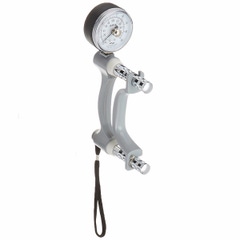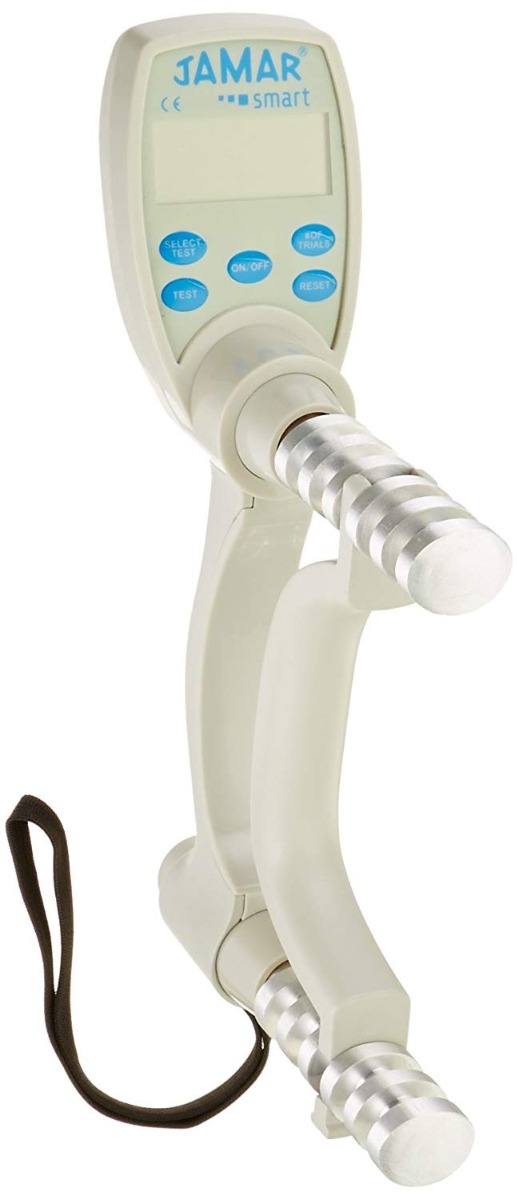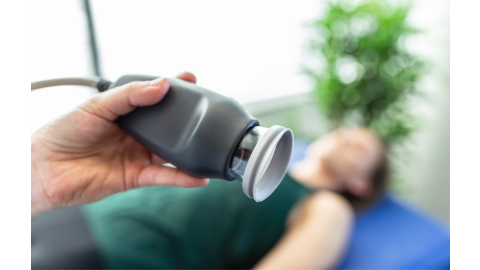What You Need to Know About Hand Dynamometers
Are you trying to decide if your clinic needs a new hand dynamometer? Or maybe you’ve been looking at ways to measure grip strength and are wondering what the word “dynamometer” even means. Whether you’re a therapist or hand surgeon, if you want to know more about hand dynamometers, you’re in the right place.
What is a hand dynamometer and how does it work?
A hand dynamometer is an evaluation tool that’s used to measure isometric grip force (hand grip strength). Some versions use hydraulics to measure the force while others use electronic load cells. Once the grip position is adjusted, the user holds the handle and squeezes the handle. The peak hold needle will keep the highest rating on a hydraulic version until reset, while the digital version automatically displays the test results.
Why do I need a hand dynamometer?

A variety of medical professionals use hand dynamometers. If you are a certified hand therapist, occupational therapist, or physical therapist focused on tracking patient progress this tool is an easy way to measure strength improvements in therapy. It can be used by hand surgeons to measure a patient’s grip before and after surgery. Lastly, it can also be used as part of independent medical exams to help determine if a patient is ready to return to work. Hand dynamometers are excellent tools when conducting hand evaluations.
In addition to being used in hospitals and clinics, many researchers also use hand dynamometers in studies examining grip strength. These studies may explore how grip strength can be used as an indicator of patient health or other hand strength topics.
How do I use a hand dynamometer for grip strength testing?

Follow the instructional manual that comes with your hand dynamometer or the standard operating procedure for your institution. Hydraulic and digital options will have different features. Overall, a standard grip strength test will follow these steps.
- Adjust the grip handle position to fit the user
- Have the user sit with their feet flat on the floor and their arms at right angles, with the elbow beside the body
- The user should then hold the hand dynamometer with their fingers wrapped around one side of the handle and their thumb around the other side
- Make sure the dynamometer is reset and tell the user they will feel no resistance
- Instruct the user to squeeze as hard as possible, by prompting them to “Squeeze, harder, harder... stop squeezing”
- Record the measurements and repeat for multiple trials, as needed
How are hand dynamometers used in research?

Hand dynamometers, specifically the Jamar brand which is known for its reliability, are often used in grip strength studies.
Study 1: Prognostic value of grip strength: Findings from the Prospective Urban Rural Epidemiology (PURE) study
Participants: 139,691 people from 17 countries
Results: Grip strength (measured with a Jamar hand dynamometer) was inversely associated with all-cause, cardiovascular and non-cardiovascular mortality, as well as myocardial infarction and stroke. The study found that grip strength was a stronger predictor of all-cause and cardiovascular mortality than systolic blood pressure. However, there was no significant association found between grip strength and incident diabetes, risk of hospital admission for pneumonia or COPD, injury from falls, or fracture.
This suggests that measuring and tracking grip strength could be an inexpensive way to access the patient’s risk of cardiovascular disease and other conditions.
Study 2: Grip Strength Is Associated with Longitudinal Health Maintenance and Improvement in Adolescents
Participants: 368 elementary school children
Results: This study used a hand dynamometer to measure normalized grip strength (NGH) in children. It found that adolescents with low NGS had a higher prevalence of health decline or poor health persistence over a two year period, compared to those who were strong. Additionally, adolescents with a strong NGS were more likely to have health maintenance or health improvement even after adjusting for factors like objectively measured physical fitness.
This research also shows the importance of grip strength as a predictor for health, this time in children. Grip strength tests are a simple way to identify patients that need further intervention to improve their health.
Study 3: Combination of measures of handgrip strength and red cell distribution width can predict in-hospital complications better than the ASA grade after hip fracture surgery in the elderly
Participants: 83 consecutive patients operated on for hip fracture surgeries (identified retrospectively)
Results: 52% of patients were admitted to the intensive care unit (ICU) after surgery. The study found that a higher American Society of Anesthesiologists (ASA) grading and grip strength could each independently predict ICU admission. The research also found that the combination of red cell distribution width (RDW) and grip strength outweighed the ASA grade in predictive ability. Grip strength was measured using a Jamar digital hand dynamometer.
This study shows that utilizing grip strength testing in hospitals and clinical settings, along with RDW and ANA grades, can help detect high-risk patients early and improve their outcome post hip fracture surgery.
How to Choose the Best Hand Dynamometer

If you’ve decided that a hand dynamometer makes sense for your clinical or hospital setting, your next step is choosing the right one! Decide if you want a hydraulic or digital version.
What does the research say about hand dynamometers?
A study by Virgil Mathiowetz (2002) says the Jamar Hydraulic Hand Dynamometer has become the “gold standard” for measuring hand grip strength. He says this is due to a few factors including:
- Recommendation by the American Society of Hand Therapists and others
- Good to excellent test–retest reliability (r = 0.88 to 0.93)
- Excellent interrater reliability (r = 0.99)
- The availability of normative data for children and adults
By popular choice, this standard hydraulic hand dynamometer is frequently used in research. However, many researchers are beginning to switch to digital hand dynamometers due to their accuracy and ease of use.

Why should you choose a digital hand dynamometer?
Digital hand dynamometers have increased accuracy and no leaking hydraulic oil thanks to their electronic load cells. Whether you’re looking for your first dynamometer or want to make the switch from hydraulics, we recommend the Jamar Smart Digital Hand Dynamometer.
Here’s a few benefits to consider when choosing a digital hand dynamometer:
- Automatic calculations of the average, standard deviation, and coefficient of variation eliminate the possibility of mathematical calculation errors
- The Jamar Smart App tablet allows you to graph patient results, save the test results for review, and export the data as a PDF
- There is a free Jamar Digital Hand Dynamometer Grip Strength Norms Calculator which uses NIH normative data for the Jamar digital hand dynamometers
- It supports six different tests
- Standard test single hand
- Standard test left hand
- Standard test right hand
- Standard test left and right hand
- Rapid exchange grip test 1.5 seconds intervals
- Rapid exchange grip test 3 seconds intervals
- Overall, the digital hand dynamometer will allow you to spend less time calculating numbers and more time with your patients
Now that you know the basics about hand dynamometers, be smart and choose the Jamar Smart Digital Hand Dynamometer for your clinic!
References
Baylor University. (2018). Grip strength of children gives clues about their future health: Measuring hand grip can help identify youths who could benefit from lifestyle changes. ScienceDaily. Retrieved from https://bit.ly/2B1CnB5
Ji HM, et al. (2017). Combination of measures of handgrip strength and red cell distribution width can predict in-hospital complications better than the ASA grade after hip fracture surgery in the elderly. BMC Musculoskelet Disord. Retrieved from https://bit.ly/2PoIPLi
Leong, Darryl P et al. (2015). Prognostic value of grip strength: findings from the Prospective Urban Rural Epidemiology (PURE) study. The Lancet. Retrieved from https://bit.ly/2qDFl8B
Mathiowetz, V. (2002). Comparison of Rolyan and Jamar dynamometers for measuring grip strength. Occupational Therapy International. Retrieved from https://bit.ly/2IUc2db
Peterson M.D., et al. (2018). Grip Strength Is Associated with Longitudinal Health Maintenance and Improvement in Adolescents. The Journal of Pediatrics. Retrieved from https://bit.ly/2DAvj0H
Medical Disclaimer: The information provided on this site, including text, graphics, images and other material, are for informational purposes only and are not intended to substitute for professional medical advice, diagnosis or treatment. Always seek the advice of your physician or other healthcare professional with any questions or concerns you may have regarding your condition.








 France
France Australia
Australia














